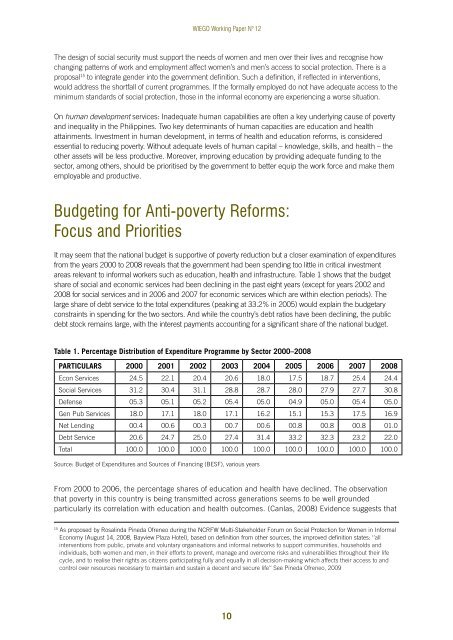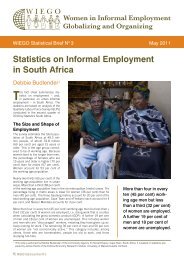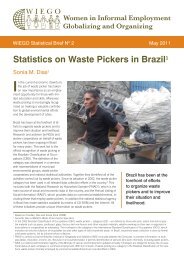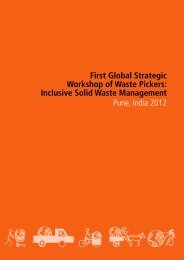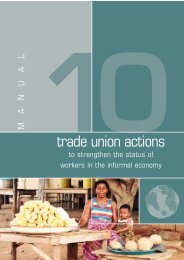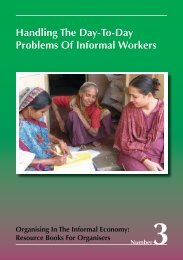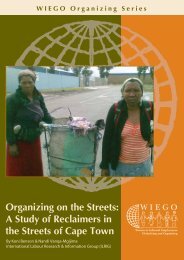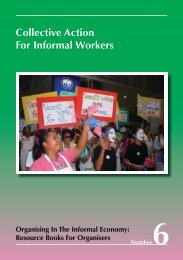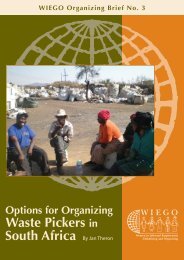<strong>WIEGO</strong> Work<strong>in</strong>g Paper N o 12From 2004 to June 2008, the government claims to have generated 9.78 million jobs that benefitedmajority of those from the marg<strong>in</strong>alised sectors such as farmers <strong>and</strong> fisher-folk, ambulant vendors <strong>and</strong>small traders who borrowed money from microf<strong>in</strong>ance, <strong>and</strong> unskilled workers who were hired <strong>in</strong> theconstruction of houses <strong>and</strong> roads. This, accord<strong>in</strong>g to the government, resulted from build<strong>in</strong>g up key<strong>in</strong>dustries such as <strong>in</strong>formation communication technology (ICT), tourism, hous<strong>in</strong>g, m<strong>in</strong><strong>in</strong>g, <strong>and</strong> extend<strong>in</strong>gloans to micro-, small <strong>and</strong> medium enterprises, develop<strong>in</strong>g two million hectares of l<strong>and</strong> for agribus<strong>in</strong>ess.However, most of the jobs generated are characterised by low productivity, below poverty-level wages <strong>and</strong><strong>in</strong>secure work<strong>in</strong>g conditions, aside from be<strong>in</strong>g seasonal <strong>and</strong> short-term <strong>in</strong> nature.While microf<strong>in</strong>ance has <strong>in</strong>creased significantly <strong>in</strong> the past 10 years to help fill the unmet needs forf<strong>in</strong>ancial services, a majority of poor families, especially <strong>in</strong> the poorer regions, still do not have access tothese services. Those <strong>in</strong> the poorer regions, particularly the women who are engaged <strong>in</strong> microenterprises,consider bank loan offer<strong>in</strong>gs as generally <strong>in</strong>accessible due to their str<strong>in</strong>gent requirements <strong>in</strong> the m<strong>in</strong>imumloanable amount, quality of collateral, repayment terms, number of years of bus<strong>in</strong>ess experience <strong>and</strong>submission of bus<strong>in</strong>ess plans.In relation to microf<strong>in</strong>ance as poor women’s tool for upliftment from poverty, is Lucila Lazo’s (2008: 59–60)observes that ‘the MTPDP recognises that <strong>in</strong> order for micro-f<strong>in</strong>ance to be a susta<strong>in</strong>able tool for povertyalleviation, especially among women who comprise a majority of its clientele, there is a need to <strong>in</strong>tegratesocial services (like <strong>in</strong>surance <strong>and</strong> family plann<strong>in</strong>g services) <strong>and</strong> other concerns (gender equality/ women’sempowerment) <strong>in</strong>to the microf<strong>in</strong>ance <strong>in</strong>stitutions’ (MFIs’) programme.’Lazo also commented on the slow or flawed execution of the government’s enterprise development laws<strong>and</strong> programmes <strong>in</strong> terms of target <strong>and</strong> reach. In particular, Lazo cited the absence of a special creditw<strong>in</strong>dow for women entrepreneurs as per RA 7882 (Assistance to Women Engag<strong>in</strong>g <strong>in</strong> Micro <strong>and</strong> CottageBus<strong>in</strong>ess Enterprises <strong>and</strong> for Other Purposes, 1995). Most women currently access credit from the microenterpriselend<strong>in</strong>g w<strong>in</strong>dows of government as well as NGO or cooperative operated micro-enterprise lend<strong>in</strong>gw<strong>in</strong>dows that have small, non-collateralised loan ceil<strong>in</strong>gs. 13Overall, the key challenge is to develop mechanisms enabl<strong>in</strong>g microf<strong>in</strong>ance to reach agriculture <strong>and</strong> growat a substantially accelerated pace <strong>in</strong> order to achieve national outreach <strong>and</strong> necessary susta<strong>in</strong>ability.On social protection <strong>and</strong> welfare: The NEDA Board-Social Development Council (SDC) Resolution No. 1s2007 def<strong>in</strong>es social protection as ‘consist<strong>in</strong>g of policies <strong>and</strong> programmes that seek to reduce poverty<strong>and</strong> vulnerability to risks <strong>and</strong> enhance the social status <strong>and</strong> rights of the marg<strong>in</strong>alised by promot<strong>in</strong>g<strong>and</strong> protect<strong>in</strong>g livelihood <strong>and</strong> employment, protect<strong>in</strong>g aga<strong>in</strong>st hazards <strong>and</strong> sudden loss of <strong>in</strong>come, <strong>and</strong>improv<strong>in</strong>g people’s capacity to manage risks.’ The components of social protection under this def<strong>in</strong>ition<strong>in</strong>clude: Labour Market – measures aimed at enhanc<strong>in</strong>g employment opportunities <strong>and</strong> protectionof the rights <strong>and</strong> welfare of workers implemented by the Department of Labour <strong>and</strong> Employment(DOLE), Department of Agriculture (DA) <strong>and</strong> Department of Agrarian Reform (DAR); Social Insurance– programmes that seek to mitigate <strong>in</strong>come risks by pool<strong>in</strong>g resources <strong>and</strong> spread<strong>in</strong>g risks acrosstime <strong>and</strong> classes implemented by the Department of Health (DOH) <strong>and</strong> Philipp<strong>in</strong>e Health InsuranceCorporation (PHIC); Social Welfare – preventive <strong>and</strong> developmental <strong>in</strong>terventions that seek to support them<strong>in</strong>imum basic requirements of the poor <strong>and</strong> reduce risks associated with unemployment, resettlement,marg<strong>in</strong>alisation, illness, disability, old age <strong>and</strong> family care implemented by the Department of Social Welfare<strong>and</strong> Development (DSWD); <strong>and</strong> safety nets 14 provided through the DSWD.13There are three ma<strong>in</strong> lend<strong>in</strong>g w<strong>in</strong>dows currently accessible to women <strong>in</strong> micro-enterprises: a) the Grameen Programme providesthe bottom 30 percent of rural women with agricultural credit without need for collateral; b) PCFC reportedly served 864,965beneficiaries (from June 2001 to December 2003), of which about 985 were recorded as women; c) the Development Bank of thePhilipp<strong>in</strong>es (DBP) reported reach<strong>in</strong>g an <strong>in</strong>creas<strong>in</strong>g number of women beneficiaries—from 121 <strong>in</strong> 1998 to more than 9,600 <strong>in</strong> 2001.14Includ<strong>in</strong>g stop-gap mechanisms or urgent responses that address effects of economic shocks, disasters, <strong>and</strong> calamities on specificvulnerable groups9
<strong>WIEGO</strong> Work<strong>in</strong>g Paper N o 12The design of social security must support the needs of women <strong>and</strong> men over their lives <strong>and</strong> recognise howchang<strong>in</strong>g patterns of work <strong>and</strong> employment affect women’s <strong>and</strong> men’s access to social protection. There is aproposal 15 to <strong>in</strong>tegrate gender <strong>in</strong>to the government def<strong>in</strong>ition. Such a def<strong>in</strong>ition, if reflected <strong>in</strong> <strong>in</strong>terventions,would address the shortfall of current programmes. If the formally employed do not have adequate access to them<strong>in</strong>imum st<strong>and</strong>ards of social protection, those <strong>in</strong> the <strong>in</strong>formal economy are experienc<strong>in</strong>g a worse situation.On human development services: Inadequate human capabilities are often a key underly<strong>in</strong>g cause of poverty<strong>and</strong> <strong>in</strong>equality <strong>in</strong> the Philipp<strong>in</strong>es. Two key determ<strong>in</strong>ants of human capacities are education <strong>and</strong> healthatta<strong>in</strong>ments. Investment <strong>in</strong> human development, <strong>in</strong> terms of health <strong>and</strong> education reforms, is consideredessential to reduc<strong>in</strong>g poverty. Without adequate levels of human capital – knowledge, skills, <strong>and</strong> health – theother assets will be less productive. Moreover, improv<strong>in</strong>g education by provid<strong>in</strong>g adequate fund<strong>in</strong>g to thesector, among others, should be prioritised by the government to better equip the work force <strong>and</strong> make thememployable <strong>and</strong> productive.<strong>Budget</strong><strong>in</strong>g for Anti-poverty Reforms:Focus <strong>and</strong> PrioritiesIt may seem that the national budget is supportive of poverty reduction but a closer exam<strong>in</strong>ation of expendituresfrom the years 2000 to 2008 reveals that the government had been spend<strong>in</strong>g too little <strong>in</strong> critical <strong>in</strong>vestmentareas relevant to <strong>in</strong>formal workers such as education, health <strong>and</strong> <strong>in</strong>frastructure. Table 1 shows that the budgetshare of social <strong>and</strong> economic services had been decl<strong>in</strong><strong>in</strong>g <strong>in</strong> the past eight years (except for years 2002 <strong>and</strong>2008 for social services <strong>and</strong> <strong>in</strong> 2006 <strong>and</strong> 2007 for economic services which are with<strong>in</strong> election periods). Thelarge share of debt service to the total expenditures (peak<strong>in</strong>g at 33.2% <strong>in</strong> 2005) would expla<strong>in</strong> the budgetaryconstra<strong>in</strong>ts <strong>in</strong> spend<strong>in</strong>g for the two sectors. And while the country’s debt ratios have been decl<strong>in</strong><strong>in</strong>g, the publicdebt stock rema<strong>in</strong>s large, with the <strong>in</strong>terest payments account<strong>in</strong>g for a significant share of the national budget.Table 1. Percentage Distribution of Expenditure Programme by Sector 2000–2008PARTICULARS 2000 2001 2002 2003 2004 2005 2006 2007 2008Econ Services 24.5 22.1 20.4 20.6 18.0 17.5 18.7 25.4 24.4Social Services 31.2 30.4 31.1 28.8 28.7 28.0 27.9 27.7 30.8Defense 05.3 05.1 05.2 05.4 05.0 04.9 05.0 05.4 05.0Gen Pub Services 18.0 17.1 18.0 17.1 16.2 15.1 15.3 17.5 16.9Net Lend<strong>in</strong>g 00.4 00.6 00.3 00.7 00.6 00.8 00.8 00.8 01.0Debt Service 20.6 24.7 25.0 27.4 31.4 33.2 32.3 23.2 22.0Total 100.0 100.0 100.0 100.0 100.0 100.0 100.0 100.0 100.0Source: <strong>Budget</strong> of Expenditures <strong>and</strong> Sources of F<strong>in</strong>anc<strong>in</strong>g (BESF), various yearsFrom 2000 to 2006, the percentage shares of education <strong>and</strong> health have decl<strong>in</strong>ed. The observationthat poverty <strong>in</strong> this country is be<strong>in</strong>g transmitted across generations seems to be well groundedparticularly its correlation with education <strong>and</strong> health outcomes. (Canlas, 2008) Evidence suggests that15As proposed by Rosal<strong>in</strong>da P<strong>in</strong>eda Ofreneo dur<strong>in</strong>g the NCRFW Multi-Stakeholder Forum on Social Protection for Women <strong>in</strong> <strong>Informal</strong><strong>Economy</strong> (August 14, 2008, Bayview Plaza Hotel), based on def<strong>in</strong>ition from other sources, the improved def<strong>in</strong>ition states: ‘’all<strong>in</strong>terventions from public, private <strong>and</strong> voluntary organisations <strong>and</strong> <strong>in</strong>formal networks to support communities, households <strong>and</strong><strong>in</strong>dividuals, both women <strong>and</strong> men, <strong>in</strong> their efforts to prevent, manage <strong>and</strong> overcome risks <strong>and</strong> vulnerabilities throughout their lifecycle, <strong>and</strong> to realise their rights as citizens participat<strong>in</strong>g fully <strong>and</strong> equally <strong>in</strong> all decision-mak<strong>in</strong>g which affects their access to <strong>and</strong>control over resources necessary to ma<strong>in</strong>ta<strong>in</strong> <strong>and</strong> susta<strong>in</strong> a decent <strong>and</strong> secure life’‘ See P<strong>in</strong>eda Ofreneo, 200910


